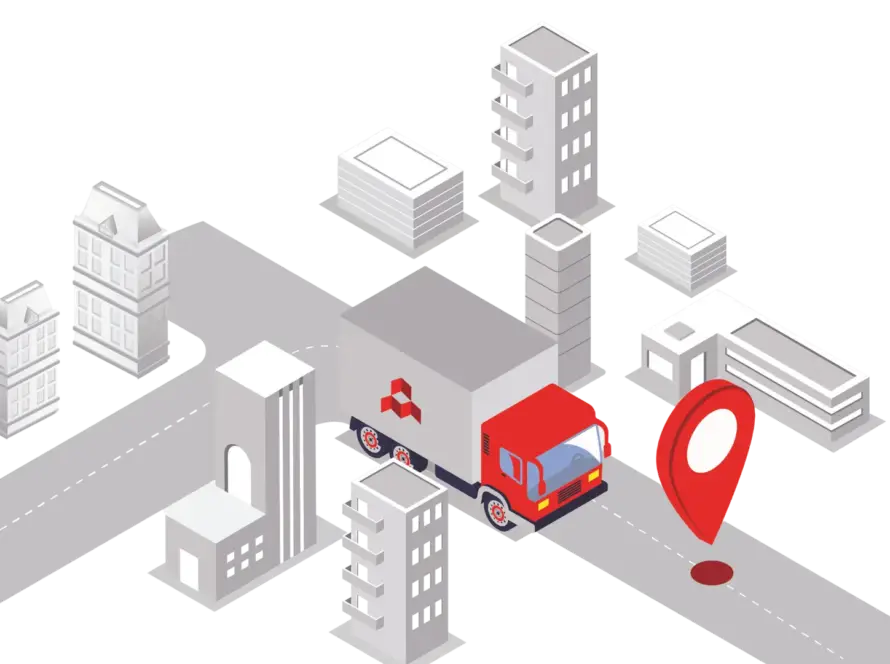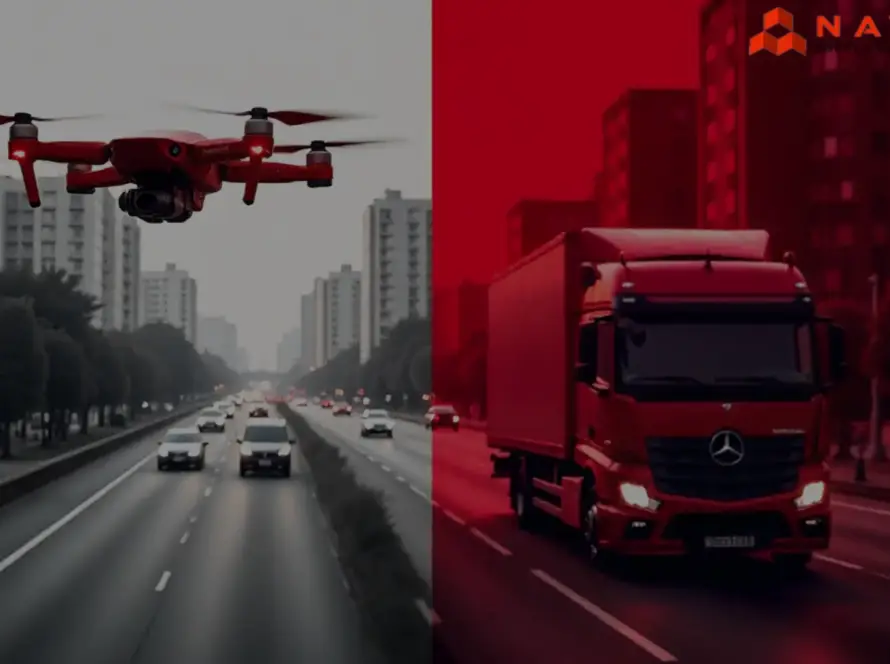Road Transportation vs Rail Transportation
Logistics and supply chain management operate through transportation which enables the smooth delivery of products from producers to consumers. The selection of transportation modes creates substantial effects on operational efficiency together with delivery speed and cost efficiency.
Road transportation together with rail transportation represents the principal transport methods that businesses utilize for their operations. Businesses must understand both the benefits and drawbacks of these modes because their choice will determine supply chain optimization. Long-distance bulk shipments benefit from rail transport because it combines cost efficiency with reduced environmental impact whereas road transport provides flexibility through last-mile delivery.
This blog presents a thorough analysis of road transportation vs rail transportation by evaluating their price structures alongside operational efficiency and flexibility as well as environmental sustainability to assist companies in their decision-making process.
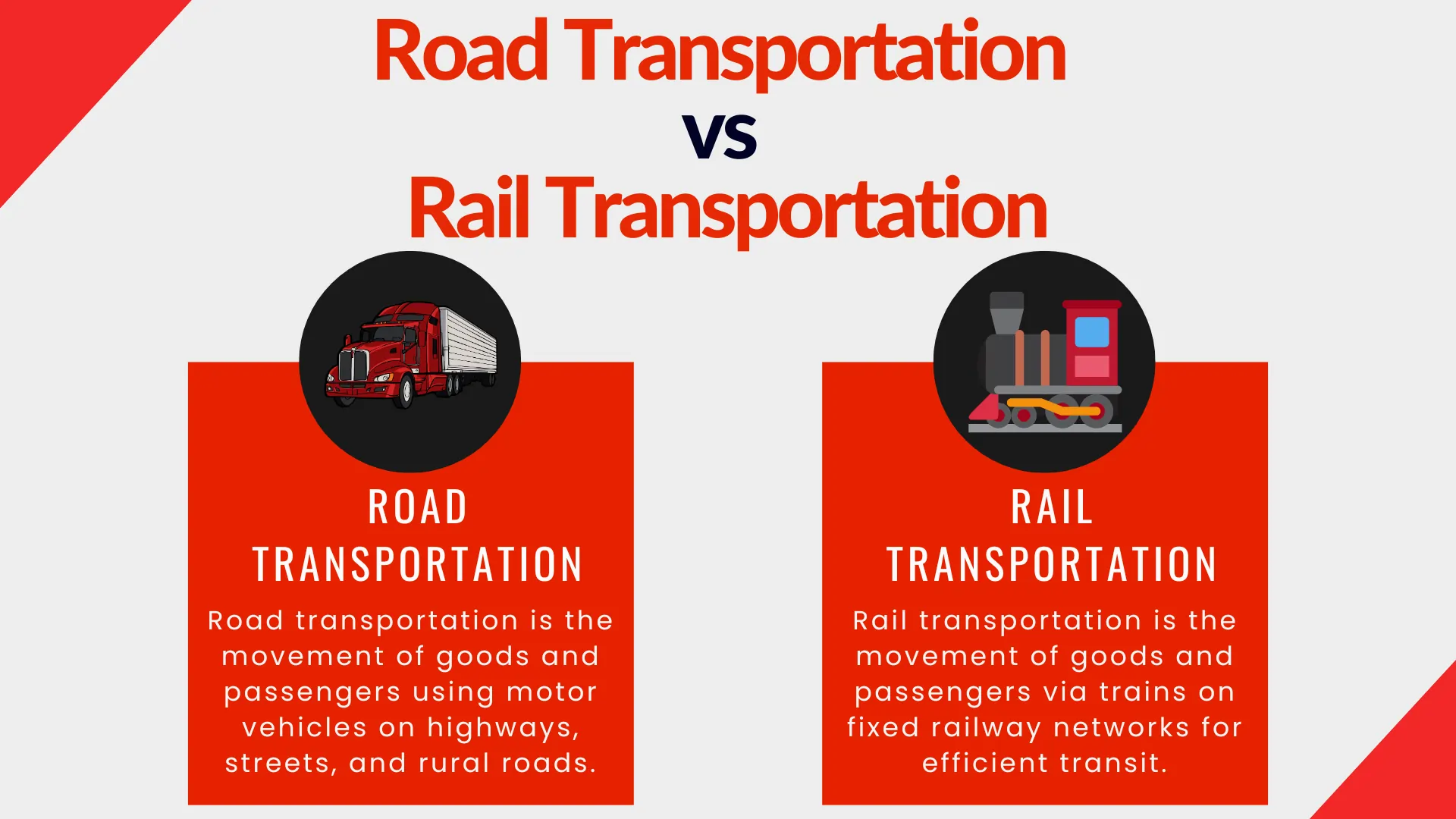
Overview of Road Transportation
Road transportation is the movement of products and passengers using motor vehicles such as trucks, vans, and automobiles on highways, streets, and country roads. It is one of the most popular forms of transportation because of its versatility and accessibility. Goods may be carried straight from source to destination, eliminating the need for intermediate processing, and making it perfect for last-mile delivery.
Key Advantages of Road Transportation
Door-to-Door Delivery – Road transport allows direct delivery of goods to end customers, eliminating the need for additional handling or transfers.
Flexibility – Unlike rail transport, which follows fixed routes and schedules, road transport can adapt to changing demands and urgent shipments.
Accessibility to Remote Locations – Road networks reach rural and underdeveloped areas where rail connectivity may not be available, making it essential for businesses operating in diverse regions.
Limitations of Road Transportation
Congestion and Traffic Delays – Roads, especially in urban areas, are prone to congestion, leading to unpredictable delays in delivery schedules.
Fuel Dependency and Rising Costs – Road transport relies heavily on fuel, making it vulnerable to fluctuations in fuel prices, which can impact operational costs.
Weather Impact – Adverse weather conditions, such as heavy rainfall, snow, and storms, can disrupt road transport operations and delay shipments.
Despite these limitations, road transportation remains a preferred choice for short to medium-distance logistics, particularly for industries that require speed, flexibility, and last-mile delivery solutions.
Overview of Rail Transportation
Rail transportation is the movement of goods and passengers by trains that operate on a fixed railway network. It is widely utilized for bulk cargo, long-distance freight transportation, and large-capacity shipments. Trains run on planned routes, making them a dependable choice for enterprises that require large-scale logistical solutions.
Key Advantages of Rail Transportation
Cost-Effectiveness for Bulk Goods – Rail transport is more economical for moving heavy and voluminous cargo over long distances, reducing per-unit transportation costs.
Lower Carbon Footprint – Compared to road transport, rail emits fewer greenhouse gases per ton-kilometer, making it a more environmentally friendly choice.
Efficiency Over Long Distances – Trains can carry significantly larger loads with fewer stops, ensuring efficient transportation of goods across regions.
Limitations of Rail Transportation
Fixed Routes and Schedules – Unlike road transport, railways operate on predefined routes and timetables, limiting flexibility for customized deliveries.
Infrastructure Dependency – The availability of rail transport depends on well-developed railway networks, which may not be accessible in certain regions.
Longer Transit Times – Since trains follow specific schedules and require handling at terminals, deliveries may take longer compared to road transport, especially for time-sensitive shipments.
Despite these challenges, rail transportation remains a highly viable option for industries that prioritize cost savings, sustainability, and bulk freight movement over extended distances.
Cost Comparison: Road Transportation vs Rail Transportation
Cost is a major factor when selecting between road transportation and rail transportation, as each mode has different expenses associated with it. The right choice depends on factors like distance, cargo type, fuel consumption, and infrastructure requirements. Let’s break down the cost aspects in detail.
Initial Investment vs. Operational Costs
Road Transportation:
- Requires relatively low initial investment. Businesses can purchase or lease trucks, which makes entry easier.
- Operational costs are higher due to fuel consumption, driver wages, toll charges, maintenance, and insurance.
- Small and medium-sized businesses prefer road transport as they can start operations with fewer financial resources.
Rail Transportation:
- Involves high initial investment in railway infrastructure, locomotives, and freight terminals.
- However, operational costs are significantly lower, especially for bulk cargo, as fuel consumption per ton-kilometer is much lower than road transport.
- Rail transport is generally managed by large corporations or government entities, making it less flexible for small businesses.
Fuel and Maintenance Expenses
Road:
- Trucks and other road vehicles are highly dependent on diesel or gasoline, making transportation costs sensitive to fuel price fluctuations.
- Regular maintenance, tire replacements, and wear-and-tear repairs add to the total cost of operation.
- Highway tolls and parking fees also increase expenses, especially for long-haul transport.
Rail:
- Rail transport is more fuel-efficient, as trains consume less energy per ton of cargo compared to trucks.
- Trains also experience lower wear-and-tear costs because railway tracks provide a controlled environment with fewer sudden stops or rough conditions.
- Rail infrastructure maintenance is usually managed by government agencies, reducing direct maintenance costs for businesses using rail transport.
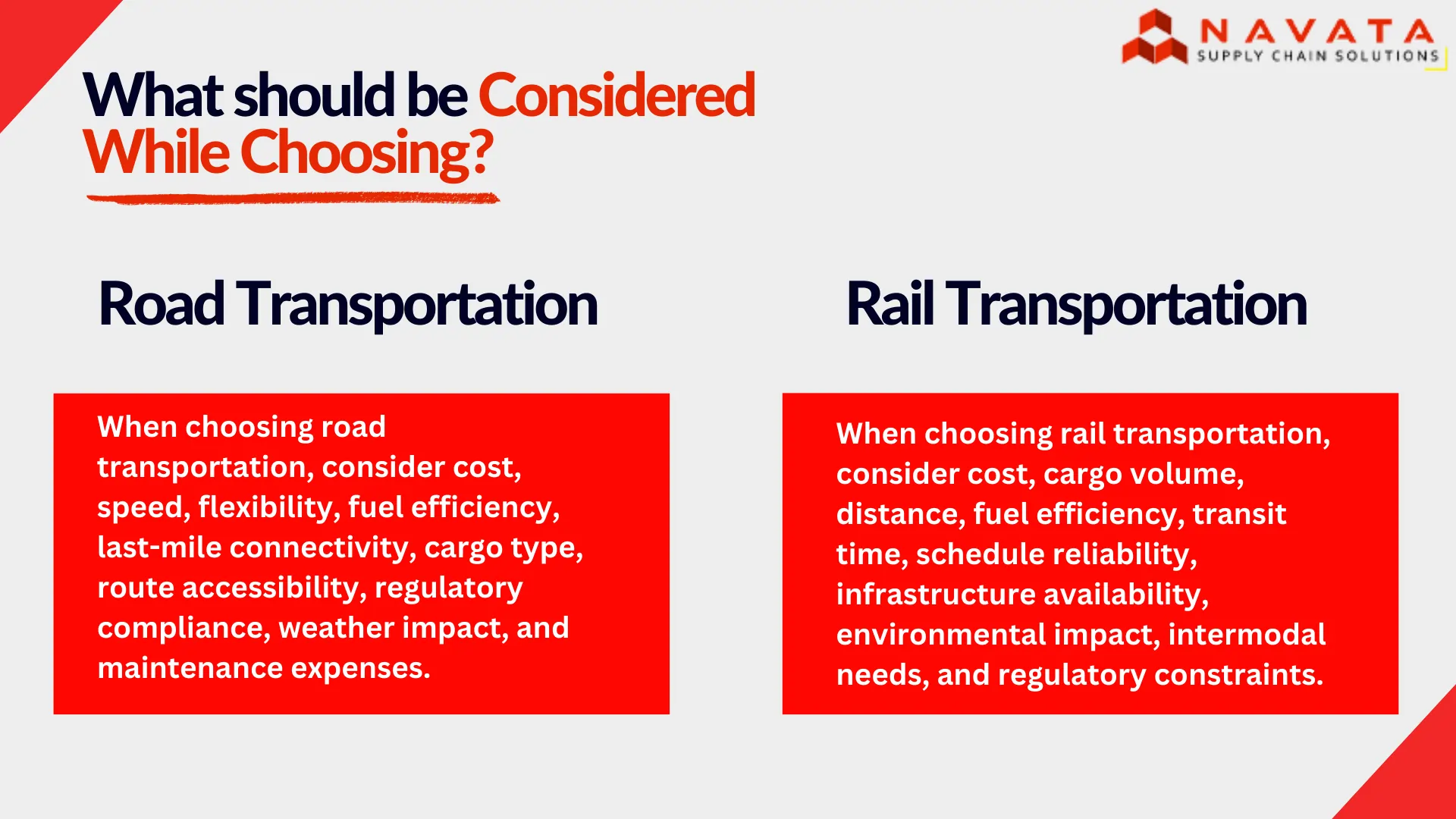
Comparing Speed and Efficiency
Short and Long Distances
For short distances, road transportation is generally faster. Trucks can take direct routes and adjust to traffic conditions, making them ideal for quick deliveries within cities or between nearby locations. They also do not require additional handling or transfers, which speeds up the process.
For long distances, rail transportation is more efficient. Trains can carry large volumes of goods with fewer stops and minimal disruptions, ensuring consistent and reliable deliveries. While they may take longer due to fixed schedules and terminal handling, they are more time-efficient for bulk cargo over extended distances.
Perishable or Time-Sensitive Goods
Road transport is preferred for perishable and time-sensitive goods such as fresh produce, pharmaceuticals, and e-commerce deliveries. Refrigerated trucks (reefers) ensure temperature control, and their flexibility allows direct delivery to warehouses or consumers without delays caused by rail schedules.
Rail transport, while efficient for bulk freight, is less ideal for perishable goods unless supported by an intermodal logistics setup. The additional time required for loading, unloading, and possible last-mile road transport can make it unsuitable for highly time-sensitive shipments. However, for non-urgent bulk perishables, specialized refrigerated rail containers can be used.
You May Also Like to Read: How Logistics Hubs Connecting Rural and Urban Markets?
Comparing Flexibility and Accessibility
Better Last-Mile Connectivity in Road Transportation
Road transportation is very versatile since it allows for door-to-door deliveries, making it the favored option for last-mile logistics. Trucks, vans, and other road vehicles can handle metropolitan streets, highways, and even country roads, ensuring that items arrive at warehouses, retail outlets, and end consumers with little handling. This versatility is critical for e-commerce, FMCG, and perishable items, which require rapid and direct delivery. Furthermore, road transport allows for on-demand shipments, route adjustments, and rapid responsiveness to market swings.
Rail Transportation Limitation in Last-Mile Connectivity
Rail transportation, while efficient for large-scale cargo across great distances, is limited by fixed routes and railway infrastructure. Trains follow predetermined schedules and can only convey products to train terminals, necessitating extra road transit for last-mile delivery. This makes rail travel unsuitable for direct-to-customer shipments, particularly in rural and distant places without adequate railway infrastructure. Businesses that rely on rail frequently require an intermodal model, in which rail travels vast distances and trucks handle final deliveries, adding complexity to logistics operations.
Environmental Impact
Emissions and Energy Consumption
The carbon emissions from road transportation exceed those of rail-based transportation by a substantial margin. Road vehicles together with trucks use diesel and gasoline fuels which generates elevated CO₂ emissions per tonne-kilometre. Stopped traffic idling causes increased fuel usage as well as generates additional air pollution together with stop-and-start driving and traffic congestion.
Rail transportation utilizes fuel more efficiently than other modes of transport. The energy-efficient transporting capacity of trains enables them to transport high quantities of goods at reduced energy expenses for lower emissions totals. Rail networks that operate with electricity improve environmental sustainability by both lowering the need for fossil fuels and decreasing greenhouse gas pollution.
Rail as a More Sustainable Option
Transportation by rail offers better environmental sustainability compared to other modes because its efficiency leads to lower emissions. The emissions output from trains reaches 75% below truck emissions while transporting one tonne over one mile. The reduced volume of traffic on rail networks helps decrease pollution that results from traffic congestion.
Sustainable governments together with businesses select rail transport for their long-haul freight operations to fulfil environmental criteria and carbon emission reduction targets. The use of rail for long-distance transportation instead of road transport in delivery operations will substantially reduce environmental effects in the logistics sector.
You May Also Like to Read: What Is Green Supply Chain Management & It’s Effects
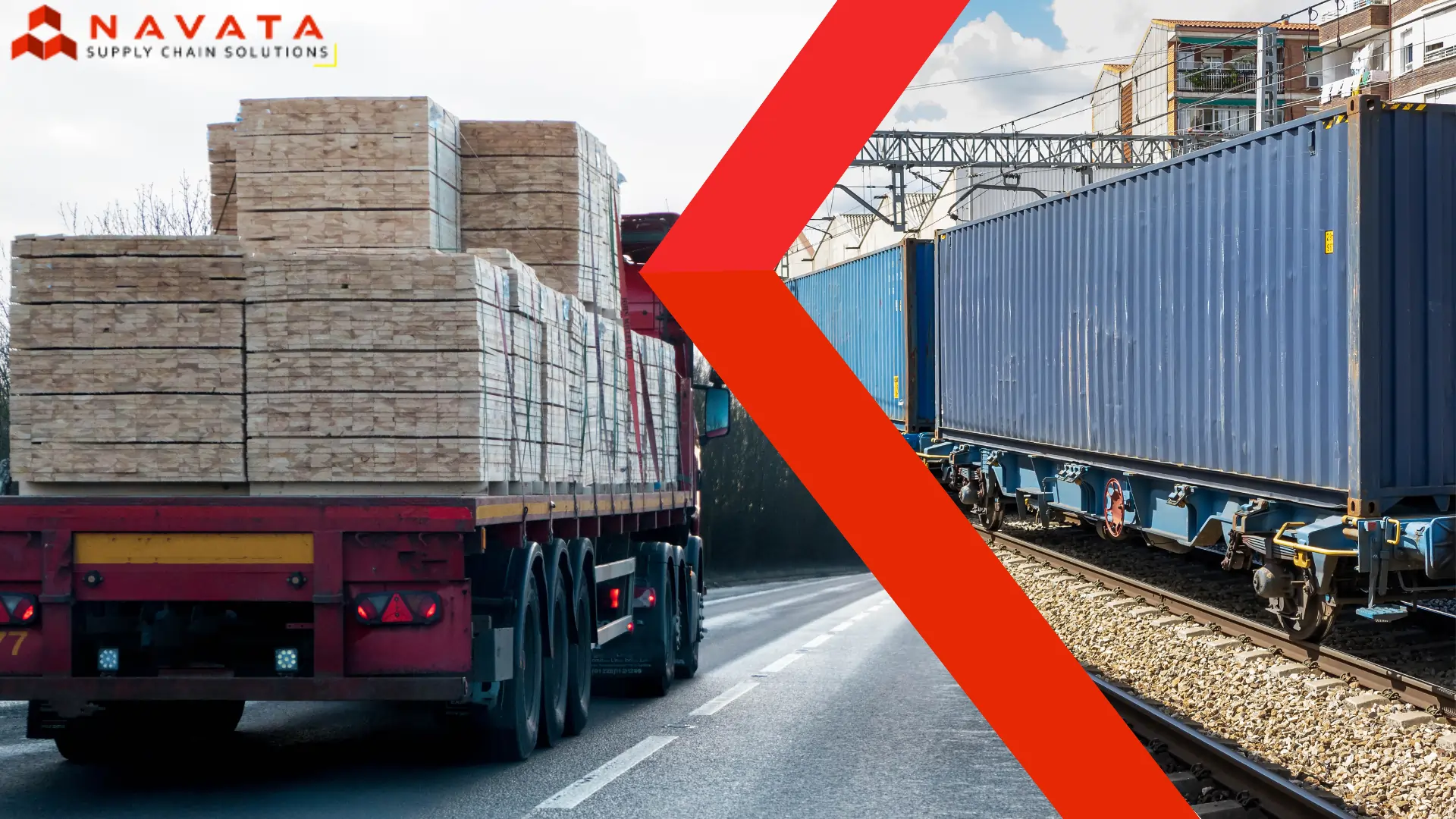
Conclusion
When deciding between road and rail transportation, consider cost, speed, flexibility, and environmental effects. Road transport is suitable for short distances, last-mile delivery, and time-sensitive commodities since it provides flexibility and accessibility. Rail transport, on the other hand, is more cost-effective and environmentally friendly for long-distance and bulk cargo, lowering emissions and fuel costs.
While vehicle transport is convenient, rail transit enables large-scale logistics with a lesser environmental effect. Businesses must assess their supply chain requirements and operational goals in order to choose the most efficient approach. In many circumstances, combining the two can improve logistical performance and cost-effectiveness.
Thank You For Reading: Road Transportation vs Rail Transportation
powered By 360Presence
